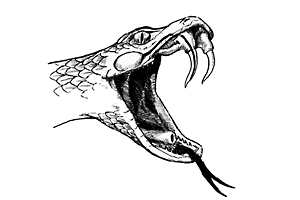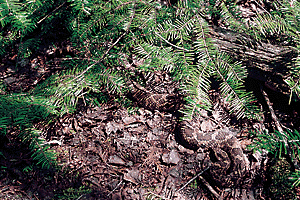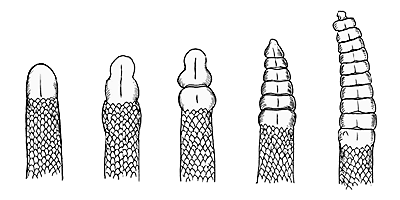How do Massasaugas Survive?
To survive in the wilderness, organisms need many
adaptations to maintain an advantage in their environment.
The massasauga is no different. To
track down its food, it has to have some way of detecting its
prey from long distance. To do this,
massasaugas use something called their vomero-nasal organ, also
known as Jacobson’s organ. The organ is
located on the roof of the mouth and has nerve endings that run
straight to the brain. Massasaugas collect
particles in the air on their tongue when they flick it out, and
then they pull their tongue back into their mouth and place it
on the organ. The organ sends the information
to the brain, which then deciphers the information.
Jacobson’s organ can also be used to locate prospective
mates, predators, and geographical locations, let alone prey.
of detecting its
prey from long distance. To do this,
massasaugas use something called their vomero-nasal organ, also
known as Jacobson’s organ. The organ is
located on the roof of the mouth and has nerve endings that run
straight to the brain. Massasaugas collect
particles in the air on their tongue when they flick it out, and
then they pull their tongue back into their mouth and place it
on the organ. The organ sends the information
to the brain, which then deciphers the information.
Jacobson’s organ can also be used to locate prospective
mates, predators, and geographical locations, let alone prey.
Another of the massasauga’s many adaptations is its pair
of
 thermal pits located on its face, one on each side of its
head, lower than the eyes and half way to the nose.
These pits enable the massasauga to sense the body heat
of its prey or other animals in its surroundings.
The presence of these thermal pits puts this rattlesnake
into a group of snakes called the pit vipers.
Pit vipers all have similar thermal pits to enhance their
senses. These pits can also be a very helpful
defensive mechanism, because the massasauga can quickly detect
predators with them as well.
thermal pits located on its face, one on each side of its
head, lower than the eyes and half way to the nose.
These pits enable the massasauga to sense the body heat
of its prey or other animals in its surroundings.
The presence of these thermal pits puts this rattlesnake
into a group of snakes called the pit vipers.
Pit vipers all have similar thermal pits to enhance their
senses. These pits can also be a very helpful
defensive mechanism, because the massasauga can quickly detect
predators with them as well.
Once the massasauga has spotted its prey with its thermal
pits, it needs a way to capture its food. It
does this with its pair of hollow fangs and its venom.
The massasauga bites and injects the venom when its fangs
are deep enough into the prey’s body. The
venom of the massasauga is actually more poisonous to mice and
other small mammals in comparison to lizards or frogs because
they have been the massasauga’s primary source of food.
The massasauga can inject venom at will when it bites, so
if it is biting out of self defense, it can conserve venom by
only biting and not injecting venom.
food. It
does this with its pair of hollow fangs and its venom.
The massasauga bites and injects the venom when its fangs
are deep enough into the prey’s body. The
venom of the massasauga is actually more poisonous to mice and
other small mammals in comparison to lizards or frogs because
they have been the massasauga’s primary source of food.
The massasauga can inject venom at will when it bites, so
if it is biting out of self defense, it can conserve venom by
only biting and not injecting venom.
 To avoid detection by prey or predators, the massasauga
has employed the use of camouflage. The brown
or gray coloring of the massasauga is perfect for hiding among
long grass and other vegetation. Their
camouflage also works in conjunction with their way of movement.
Since snakes have no legs, they slither through the
brush. Their camouflage makes them very hard
to spot as they move along the ground.
To avoid detection by prey or predators, the massasauga
has employed the use of camouflage. The brown
or gray coloring of the massasauga is perfect for hiding among
long grass and other vegetation. Their
camouflage also works in conjunction with their way of movement.
Since snakes have no legs, they slither through the
brush. Their camouflage makes them very hard
to spot as they move along the ground.
The most obvious adaptation of the massasauga rattlesnake
would have to be its rattle. The rattle is
made of specialized scales that are made up of bone on the
inside, and the rattle gets bigger every time the snake sheds
its skin. The rattle makes a rustling sound,
similar to a cicada. It primarily serves as a
warning to predators to “keep away”. Click the button
below to hear a short clip of what the rattle sounds like.
It is an mp3 file so you will need some form of a media player
to hear it. This sound clip is from the US Fish and
Wildlife service and can be found
here, listed under the reptile category.
up of bone on the
inside, and the rattle gets bigger every time the snake sheds
its skin. The rattle makes a rustling sound,
similar to a cicada. It primarily serves as a
warning to predators to “keep away”. Click the button
below to hear a short clip of what the rattle sounds like.
It is an mp3 file so you will need some form of a media player
to hear it. This sound clip is from the US Fish and
Wildlife service and can be found
here, listed under the reptile category.
See? Massasaugas are cool! Click here to learn about how massasaugas use these adaptations to eat and gain all-important nutrients!